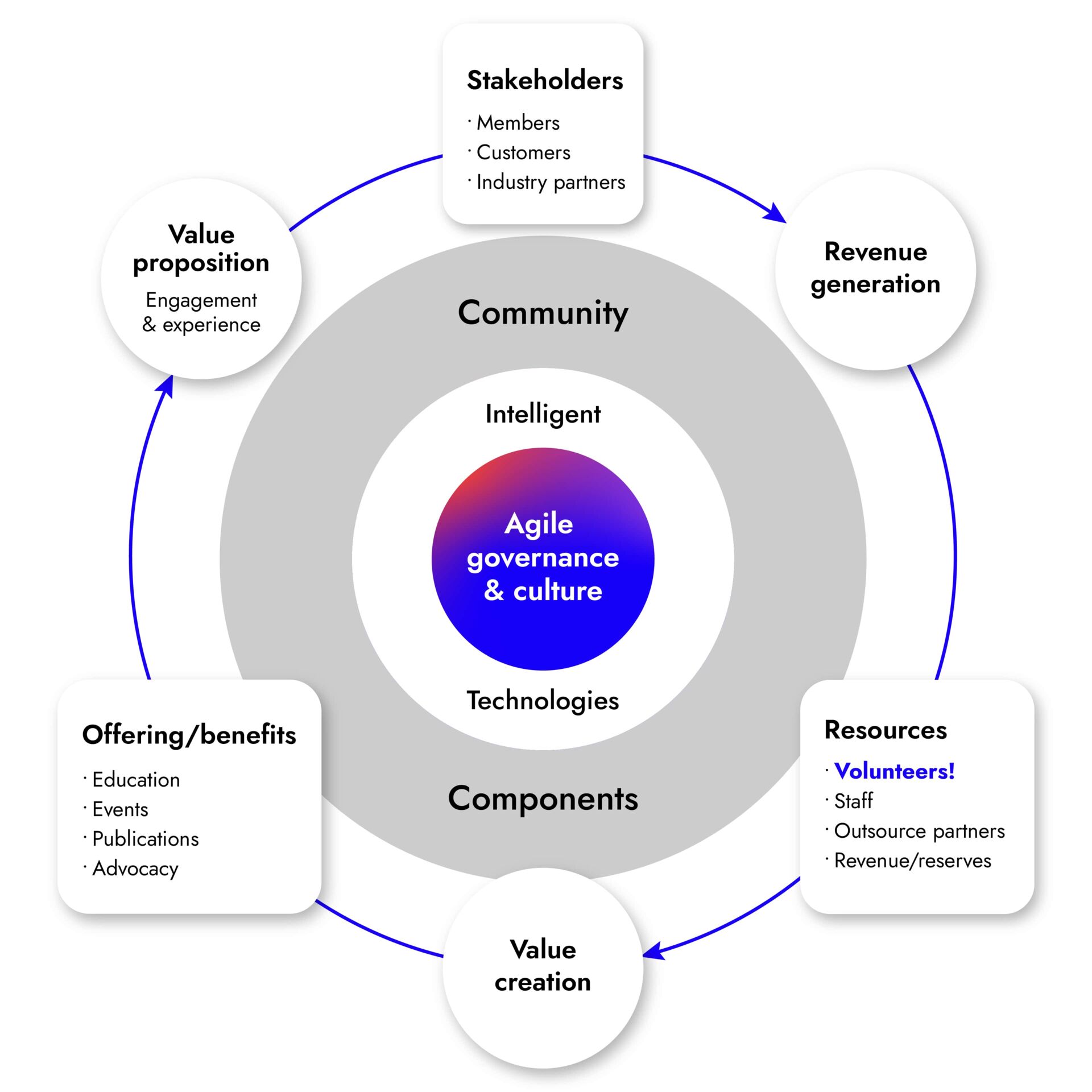Why is it important? Your FAQs answered
1. Why focus on volunteers as ambassadors instead of traditional PR?
Because members bring peer credibility that formal PR cannot replicate. Their authentic voices and lived experiences make them trusted advocates.
2. How can associations identify potential KOLs within their membership?
Look for members who consistently contribute ideas, collaborate effectively and are respected by their peers. Engagement in working groups is often a good indicator.
3. What is the first step in transforming a volunteer into a leader?
Start with small, visible opportunities that build confidence and familiarity with the association’s work, then provide mentorship and recognition.
4. How can trade associations keep company-appointed volunteers engaged?
Demonstrate the business relevance of the association’s work, while also ensuring personal value for the individual volunteer.
5. How do you maintain volunteer engagement over the long term?
Regular communication, ongoing recognition, clear pathways for growth and removing logistical barriers all contribute to sustained engagement.

For decades, many associations relied on traditional PR to communicate value and influence their sector. Today, influence is more direct, authentic and sustained. It is driven by people: volunteer leaders, key opinion leaders (KOLs) drawn from the membership whose expertise and credibility shape thinking in their field, and even association staff who act as visible, trusted ambassadors for the mission.
When volunteers are engaged and empowered to co-create, they bring credibility, passion and reach that no media strategy can match. This is a significant shift in the business model of associations, moving from seeing volunteers as contributors to recognising them as core drivers of advocacy, growth and influence.
At MCI, we see this evolution across both professional and trade associations. The most successful organisations are intentionally transforming members into ambassadors and staff into sales and engagement powerhouses.

From contributors to co-creators to leaders
Volunteers are the key component in the blueprint for management towards results. This blueprint balances:
Governance, which includes components, leaders and volunteers
Stakeholders, such as members, customers, allied organisations and industry partners
Resources, including volunteers, staff, revenues and reserves
Offerings and benefits, such as events, education, publications, advocacy, networking, guidelines and grants
Intelligent technologies, from engagement platforms to digital communications and AI
Together, these elements ensure the association can deliver on its mission and create sustained impact. At MCI, we use an association value-creation model to explain how associations fulfil their mission.
The association model:

Within that model, volunteer engagement follows a clear development path. Members may begin as consumers, attending events and benefiting from the association’s offerings. They then become contributors, taking on defined roles such as conference speaking slots or project-based tasks. From there, they can progress to collaborators, joining working groups or engaging in committee work. As their commitment deepens, they take on co-creation roles, designing programmes or leading initiatives, and finally step into leadership positions such as chairing working groups or serving on the board.
The goal is not simply to move people along this path but to do so in a way that makes their volunteer role a source of pride, visibility and professional value.
The power of communication
A common barrier to deeper volunteer engagement is a lack of communication about the “what” and “why” of volunteering. Simply announcing that volunteers are needed is not enough.
High-impact associations communicate the value of volunteering in compelling, personal terms. They match opportunities to individual members’ expertise and aspirations, explain the difference the volunteer can make, and celebrate achievements publicly. Recognition, whether through awards, profiles in newsletters or social media coverage, builds a culture in which volunteering is aspirational.
This is particularly important in trade associations, where many volunteers are appointed by their companies to serve on working groups. Their initial motivation may be tied to corporate objectives, but personal recognition and meaningful engagement can turn them into passionate advocates who go beyond the minimum expectations.
The European Society for Paediatric Endocrinology (ESPE) is an example of an organisation that took volunteer development and engagement to the next level. From the strategic plan, ESPE identified areas where volunteers are needed for undertaking future projects and initiatives. On that basis, a volunteer recruitment and engagement plan was developed. It allowed ESPE to engage volunteers for specific volunteer needs, enlarging the pool of ESPE volunteers, and anticipating a longer-term volunteer development curriculum.

Removing friction: processes, systems and support
Busy professionals will not remain engaged if volunteering feels burdensome. Associations need to make it as easy as possible for members to contribute. That means having clear governance and role definitions, including terms of reference, job descriptions and conflict of interest policies that protect both the volunteer and the organisation. Efficient logistics are also essential, such as shared file platforms, annual meeting calendars, onboarding processes and project management tools. In addition, cultural awareness is vital, particularly for global associations where diverse backgrounds and working styles must be understood and respected.
MCI often works with associations to streamline committee structures, making it easier for members to understand where and how they can contribute. For example, we helped the Society for Clinical Data Management (SCDM) restructure from 12 committees to four strategically aligned groups. This significantly improved clarity and engagement.
Aligning organisational and individual value
In trade associations, the link between volunteer engagement and corporate value is direct. Companies allocate people and resources based on perceived business relevance. The more clearly the association can demonstrate the strategic importance of its work, the more committed the company and its appointed volunteers will be.
It is essential to bridge organisational objectives with individual motivation. A working group member may be there to represent their employer, but they also have personal goals, such as expanding their network, deepening their expertise or gaining industry visibility. When both levels of value are met, engagement and advocacy are strengthened.
The case of a large international trade association (120+ bluechip companies) in the field of connected mobility, managed by MCI, illustrates how trade associations can turn “designated volunteers” into committed contributors. Member companies appoint delegates to working groups based on business priorities. While their initial engagement is often tied to corporate objectives, MCI’s approach ensures their personal motivation is also nurtured. By creating space for grassroots proposals alongside board-driven agendas, we help broaden participation and make the work professionally rewarding for individuals. This dual focus on business relevance and personal value led to more active contributions and a stronger leadership pipeline within the association.

Spotting and nurturing future leaders
A strong volunteer pipeline does not happen by accident. Associations must actively identify members with leadership potential and provide pathways for them to grow. This can mean inviting them to take on small but visible roles, offering mentorship or encouraging them to chair a project.
When we take on the management of an association, our role often includes identifying talent within working groups. We look for those who contribute thoughtfully, collaborate effectively and inspire others, and then help them progress toward leadership positions. This benefits both the individual and the association, creating ambassadors who can represent the organisation with authority and authenticity.
“The Human Factor”:
Volunteers progress from engagement to co-creation, moderation and ultimately leadership.

The evolving business model: from PR to peer influence
Traditional PR still has its place, but in the association context the most persuasive advocacy often comes from within the community. A member speaking on behalf of the association to peers, regulators or industry partners carries a level of trust that is hard to replicate.
By investing in volunteer engagement, recognition and leadership development, associations can turn their members into KOLs whose influence extends far beyond formal communication channels. The same principle applies to staff, who, through their close work with members and understanding of the industry, can become powerful advocates and relationship builders.
This is not a soft benefit. Volunteers who are emotionally invested and publicly recognised bring measurable value in member recruitment, retention, event attendance and sponsorship appeal.
From passion to impact
Transforming a volunteer into an ambassador is about activating the deep potential within individuals to advance the association’s mission. When members and staff feel ownership, pride and recognition, they are far more likely to champion the organisation in ways that drive tangible outcomes. In 3 Tips to Boost Volunteer Engagement at Your Association, Timothy Sarazen of Better Impact (a global provider of volunteer management software) writes: “Engaged volunteers show increased efficiency, feel more satisfaction in their roles, and are more likely to stick around for the long term.”
The steps are clear: define a clear engagement journey, communicate personally and persuasively, remove barriers to participation, align value for the organisation, the company and the individual, and recognise and reward consistently.
Authentic advocacy from passionate people cuts through the “noise” from traditional marketing vehicles. Associations that understand and harness this shift are fulfilling their missions by building resilient, self-sustaining engines of influence.
The most credible ambassadors for any association are its volunteers, leaders and staff. With the right structures, communication and recognition, they can extend your reach, strengthen your reputation and deliver measurable results. MCI has decades of experience helping associations turn engagement into influence and passion into impact. Let’s chat.
Glossary
KOL (Key Opinion Leader) – A respected and influential member whose expertise and credibility shape thinking within the association’s field.
Co-creation – The process of volunteers actively helping to design and shape association programmes, content or events.
Trade association – An organisation whose members are companies in a specific industry or sector.
Professional association – An organisation whose members are individual professionals, often sharing qualifications or working in the same field.
Conflict of interest – A situation where a volunteer’s personal or professional interests could influence their decisions on behalf of the association.




